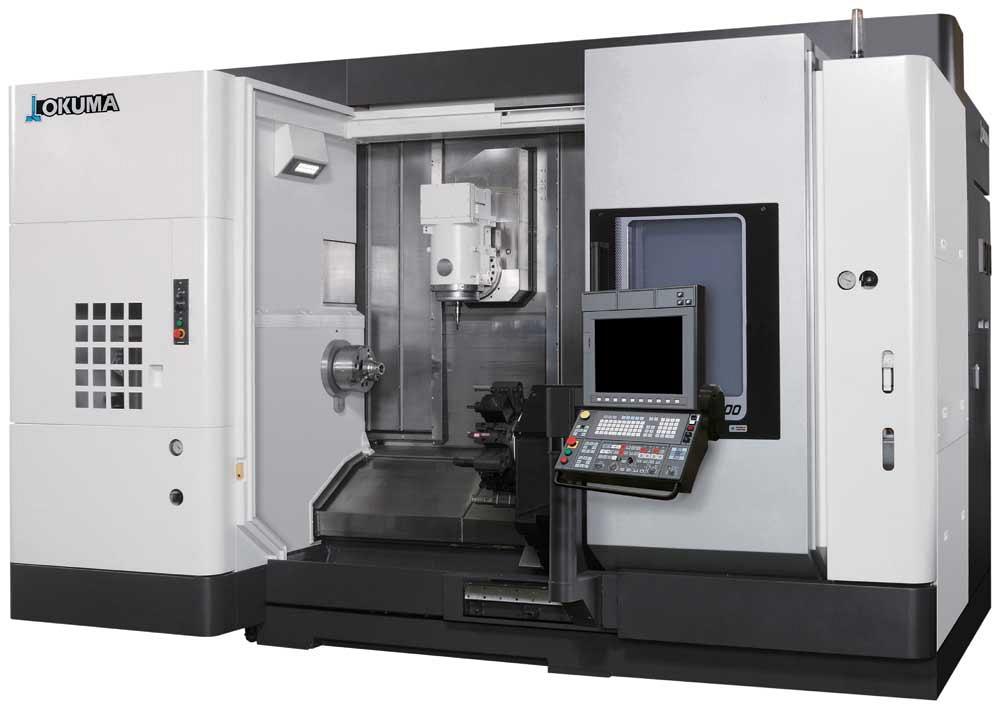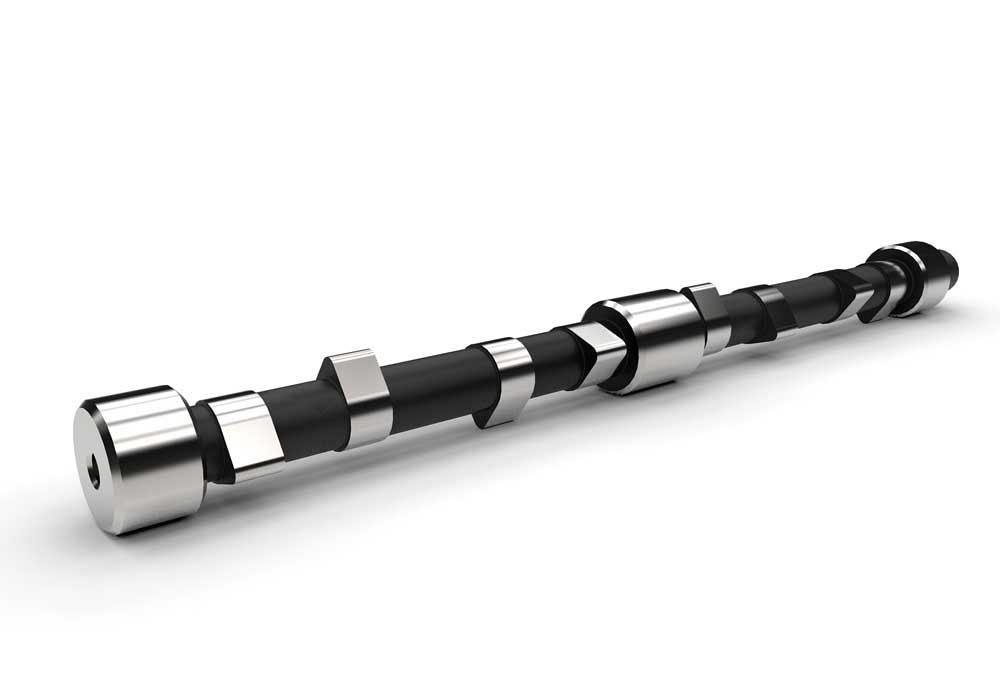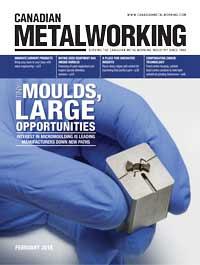- FMA
- The Fabricator
- FABTECH
- Canadian Metalworking
Eccentric turning becoming conventional work
Multitasking machines easily handle off-centre turning of part features
- By Canadian Metalworking
- February 14, 2018
- Article
- Metalworking

Modern multitasking machines like the Multus saves machinists from moving eccentric parts to an additional machine. Photo courtesy of Okuma America Corp.
When a turned part has a cross section that is unequal when referenced to its centreline, it is considered to be eccentric. Camshafts often are referred to as the most common of these workpieces, but those parts typically are manufactured on a machine solely dedicated to their production. So what is a job shop to do when an order for a part comes through the door that needs eccentric turning? The answer, surprisingly, may actually start with a milling operation.
The process of eccentric turning is similar to traditional turning only with the addition of another workpiece axis, which is parallel to the centre axis. To produce the eccentric part feature, a cutting tool removes material to the required depth as the part is turned, typically at low speed.
Canadian Metalworking asked David Fischer, lathe product specialist for Okuma America Corp., for his opinion on the process. Here's what he had to say.
CM: What type of machine setup is best suited to perform an eccentric turning operation?
Fischer: It all depends on whether the CNC lathe has a milling spindle.
If a multitasking machine is used, we recommend milling the eccentric part or part feature to a near-net shape before using a finish turning pass to complete the feature.
There is no real change to the machine structure or horsepower requirements if you start with a good, stable machining platform.
CM: What makes the milling operation important?
A good milling pass will set up a good finish turning pass, so it’s imperative to get it right. We are not going to turn the part feature from scratch because it takes too long [compared to milling] because of the low speed we run at.
In most cases, we are going to mill it to get close and just the final pass will be eccentric turning.
CM: How does the eccentric turning process affect setup?
Fischer: The traditional method of machining complex parts involves multiple machines, both lathes and mills, and creates more setup time than is necessary. Operators must make sure parts are properly aligned and measured to ensure that each part has the same dimensions as the previous one. But these setup and measurement steps aren’t needed when all of the machining operations are performed on a single machine.

The more complex the eccentric turning operation gets, the more likely it will need to be performed in separate setups or even separate machines.
If you don’t have a milling option on your lathe, then the RPMs must be reduced during turning, often to as low as 200 to 300 RPM.
You also typically want to start with a part that is as cylindrical as possible.
CM: Once the part is close to its final shape, how does the turning operation proceed?
Fischer: On Okuma machines we rotate the part on the spindle and hold the tool in the turret. We use X and Y to generate the profile and Z to drive down the part.
With eccentric turning the tool is fixed in the spindle and we use X and Y to keep it in the tangent to the surface.
At most we will do a semi-finish operation and then a finishing pass. It really depends on how close the milling process got us to the final shape. With the capability of today’s mill/turn machines, it’s possible now to get very close to the final shape.
There are RPM limitations because you are moving a lot of axes, and there is a limit to how fast you can move those axes. If you try to push things too hard, you may end up with a problem in cylindricity. And you are moving a lot of mass.
CM: How do long parts and parts with large eccentric lobes affect the process?
Fischer: If you are performing eccentric turning over a long distance, deflection will occur. This is normal in any turning operation.
For large part features, you may be creating diameters that you can’t clamp a steadyrest on because the part is so eccentric. These parts can get tricky to machine.
I often say that eccentric turning is an operation you perform when everything else has failed.
The best use of eccentric turning is when you need a turned surface on an eccentric part or part feature that requires minimal processing time, like a small journal at the front of the part. If you can machine the entire rest of the part and then have one eccentric diameter, it’s relatively easy to set up and run.
CM: What if there are many eccentric features on the part?
Fischer: Then you have to ask if you want to do another setup to make the second diameter on centre? That’s a bit of a pain because you spend more setup time or move the part to a second machine. Having a modern multitasking machine like the Multus saves you from moving to another machine. It’s not a silver bullet, but there are cases when it can prevent a major headache.
If I had a large part and the majority of it needed eccentric turning, I would probably use two separate machine setups. You do the eccentric turning in one process and the on-centre (concentric) work on another.
If it’s something like a crankshaft, I’m probably not going to do eccentric turning on that part. The reason it’s difficult is that it’s hard to get a tool down to the workpiece and it’s likely not going to produce a very good finish. Special machines are best used for these parts.
If I’m a job shop and I’m doing a one-off crankshaft, I’ll probably mill it and then send it out to get ground.
CM: What workholding requirements are necessary for eccentric turning?
Fischer: Workholding, as always, will be driven by the part. For this type of work it largely depends on where on the part the eccentric feature is located. Eccentric features at the end of the part, particularly if it’s a long part or if a tailstock is used, can be tricky to machine.
Workholding specifically for eccentric turning isn’t a high priority because all of the high-speed work typically is done first. During eccentric turning the part moves slowly, so it can generally be held in the same way you hold a totally cylindrical part.
Okuma America Corp., www.okuma.com
About the Author
Related Companies
subscribe now


Keep up to date with the latest news, events, and technology for all things metal from our pair of monthly magazines written specifically for Canadian manufacturers!
Start Your Free Subscription- Trending Articles
Identifying the hallmarks of a modern CNC

Tooling for spot facing and counterboring is completely customizable

CTMA launches another round of Career-Ready program

Collet chuck provides accuracy in small diameter cutting

Sandvik Coromant hosts workforce development event empowering young women in manufacturing

- Industry Events
MME Winnipeg
- April 30, 2024
- Winnipeg, ON Canada
CTMA Economic Uncertainty: Helping You Navigate Windsor Seminar
- April 30, 2024
- Windsor, ON Canada
CTMA Economic Uncertainty: Helping You Navigate Kitchener Seminar
- May 2, 2024
- Kitchener, ON Canada
Automate 2024
- May 6 - 9, 2024
- Chicago, IL
ANCA Open House
- May 7 - 8, 2024
- Wixom, MI















